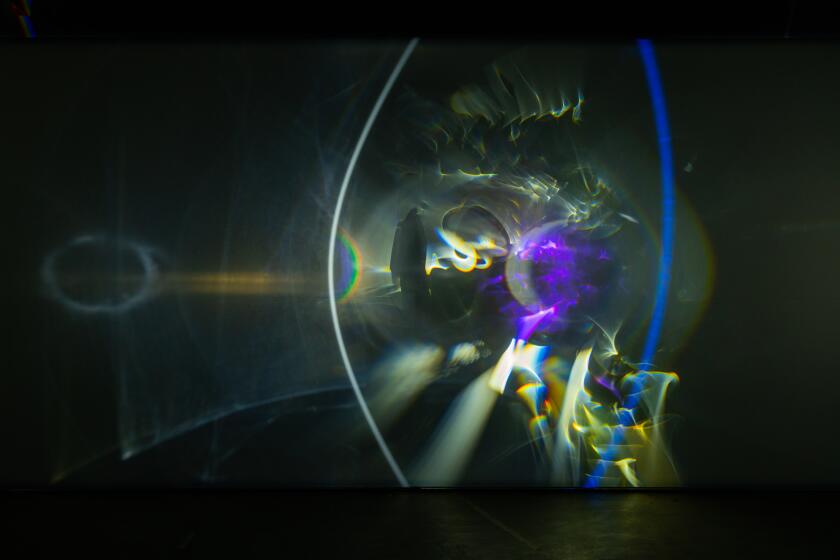Huntington’s exhibit hall for books to get $2.5-million makeover
A change is in store for the Huntington Library, Art Collections and Botanical Gardens’ main display of its rare books, manuscripts, drawings, photography and other literary and historical holdings -- including a Gutenberg Bible from the 1450s, a 1623 First Folio edition of Shakespeare’s plays and a gigantic first edition copy of John James Audubon’s “Birds of America.”
The Huntington announced Wednesday that it will close the main exhibition hall in the 92-year-old library building after June 4 for a $2.5-million face-lift that will take more than a year. When it’s done, the permanent exhibit, which hasn’t been substantially reconfigured since 1977, will have a new concept, revolving around 12 works that library director David Zeidberg describes as “landmark items.”
Each piece in the dazzling dozen -- not all of them have been picked yet, although the lavishly illustrated, 600-year-old Ellesmere Chaucer, a manuscript of Geoffrey Chaucer’s “The Canterbury Tales,” is certain to be among them -- will be a hub around which curators will cluster related or contemporaneous works, Zeidberg said. The aim is to give visitors a better understanding of the intellectual currents that were flowing through the world during the era when each of the 12 was published.
For example, the section anchored by the Shakespeare folio might also include a first-edition copy of one of Galileo’s books, palpably demonstrating that the English playwright and the Italian scientist were exercising their genius simultaneously, but in different ways.
The exhibit that’s being phased out is organized more by geography and subject, Zeidberg said, with separate sections on early books and manuscripts, British literature, American literature, American history and Southwest history.
The existing configuration still has a final chapter ahead of it: What’s currently on view will be packed up after June 4, then put back on display in late August in a new gallery that’s been carved out of a former storage area in the Erburu wing of the Huntington’s Virginia Steele Scott Galleries of American Art.
The lone exception is the Gutenberg Bible, which won’t be taken off display for even one day that the museum is open. Disappointed visitors complained the last time one of the world’s first machine-printed books was removed from view, Zeidberg said, so it will take up temporary late-spring and summer residence at the Huntington Art Gallery, a building for European art. Then it will rejoin its fellow books at the Erburu Gallery.
When the library building’s main exhibition hall reopens in 2013, Zeidberg said, it will have updated electrical, heating and air conditioning systems but retain the wood paneling installed by architect Myron Hunt. Designers are hoping to restore some missing features from the building’s early days, such as chandeliers and cork and marble flooring,
Besides reconfiguring the 3,500-square-foot main exhibition hall, the project calls for turning a smaller meeting room at the library into a gallery that will illuminate how the collection has been amassed, cared for and used by scholars -- including copies of books whose authors relied on research materials from the Huntington Library’s 9 million-piece collection of books, documents, drawings and photographs.
One element of caring for the library’s collection is not over-exposing delicate items to light. In the case of the Gutenberg Bible, Zeidberg said, that means switching off between its two volumes (an Old Testament and a New Testament) and turning pages every few weeks. Some delicate works, including the Chaucer manuscript, have modern facsimiles that allow them to get some rest in the dark (the Huntington puts placards in the display case so visitors will know when they’re looking at a facsimile rather than the product of a medieval artist-scribe).
The Huntington Library’s exhibition hall is one realm where there’s little danger of e-readers supplanting hard copies. But the project won’t ignore recent technical advances. Plans include touch screens that will allow visitors to see supplemental images and pages beyond the hundred or so works that will be on display at a given time. An audio tour is also being devised.
RELATED:
At the Huntington, a Japanese garden of new delights
Huntington buys long-missing archive of Civil War telegrams
‘Visions of Empire’ at Huntington Library looks at U.S. railroad
More to Read
The biggest entertainment stories
Get our big stories about Hollywood, film, television, music, arts, culture and more right in your inbox as soon as they publish.
You may occasionally receive promotional content from the Los Angeles Times.











